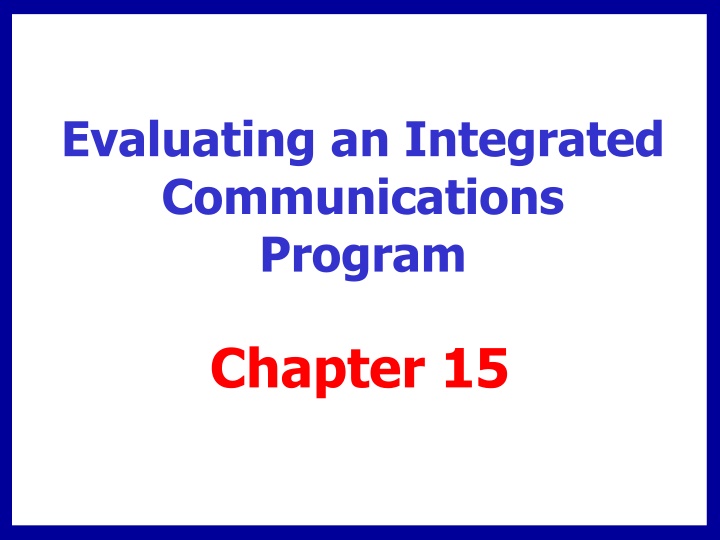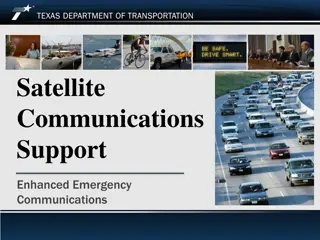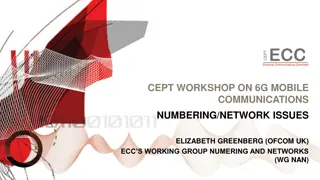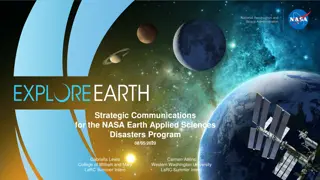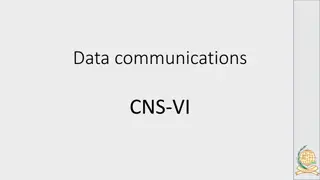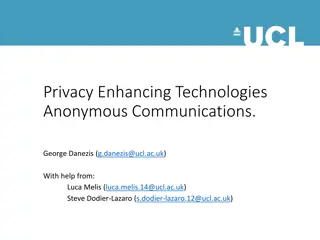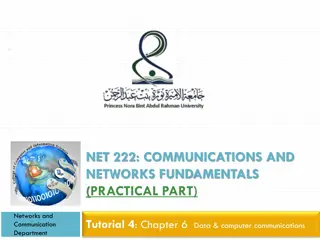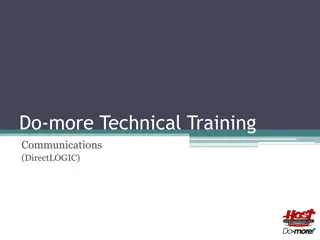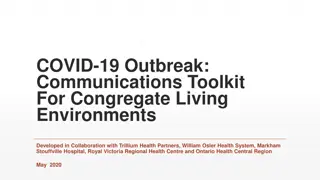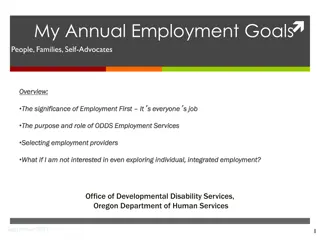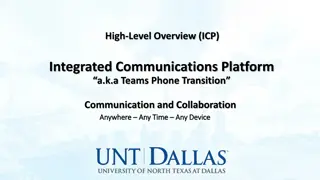Evaluating an Integrated Communications Program - Chapter 15
Delve into Chapter 15 to gain insights on evaluating an integrated communications program. Explore strategies, metrics, and best practices to measure the effectiveness of your communications efforts. Understanding the importance of evaluation and analysis can help enhance the impact of your communication initiatives and drive desired outcomes. Learn how to assess the performance of your integrated communications program and make informed decisions to optimize results and achieve your objectives.
Download Presentation

Please find below an Image/Link to download the presentation.
The content on the website is provided AS IS for your information and personal use only. It may not be sold, licensed, or shared on other websites without obtaining consent from the author.If you encounter any issues during the download, it is possible that the publisher has removed the file from their server.
You are allowed to download the files provided on this website for personal or commercial use, subject to the condition that they are used lawfully. All files are the property of their respective owners.
The content on the website is provided AS IS for your information and personal use only. It may not be sold, licensed, or shared on other websites without obtaining consent from the author.
E N D
Presentation Transcript
Evaluating an Integrated Communications Program Chapter 15
Chapter Overview I know half the money I spend on advertising is wasted, but I can never find out which half. John Wanamaker
Chapter Overview Matching methods with objectives Message evaluations Evaluation criteria Behavioral evaluations Evaluating public relations Evaluating the IMC program
Evaluation Categories Message evaluations Physical design Cognitive elements Affective elements Online evaluation metrics Real-time measures Respondent behavior evaluations Conative elements Measurable with numbers Customer actions
Evaluation and IMC Objectives Match objectives Pre- and post-tests Levels of analysis Short and long term Product-specific Corporate level
Message Evaluation Techniques Concept testing Copytesting Recall tests Recognition tests Attitude and opinion tests Emotional reaction tests Physiological tests Persuasion analysis
Evaluating Advertising Management Message Evaluation Techniques: Advertising Tracking Research Copytesting Current Future Cognitive Neuroscience Fig. 15.1
Advertising Tracking Research Track ads after launch Nielsen IAG Millward Brown Monitors Brand performance Advertising effectiveness Specific time test Continuous tracking
Copytesting Finished or final stages of development Evaluates main message and format Portfolio tests Theater tests Online tests Immediate results and lower costs Consumers pay more attention to ads Measures ad potential
Recall Tests Day-after-recall (DAR) Unaided recall Aided recall Incorrect answers Used primarily after ads launched
Items Tested for Recall Product name or brand Firm name Company location Theme music Spokesperson Tagline Incentive being offered Product attributes Marketing/advertising selling point
Sample DAR Test 30-Second TV Advertisement for Pet Food 30% Overall Recall 12.9% 24.6% 25% 21.4% 18.3% 20% 16.3% 14.6% 15% 9.4% 8.5% 10% 5% 0% Males Females Pet Dog Owners Ages 18- 35 Ages 36- 50 Ages 51+ Owners 15-12
Sample DAR Test 30-Second TV Advertisement for Pet Food 25% Test Ad Competitor A Competitor B 20% 15% 10% 5% 0% 15-13
Recall Decay Magazine Ad vs. Television Ad Magazine Television 120% 100% 80% 60% 40% 20% 0% DAR Two days later Eight days later Source: Magazines Canada s Research Archive 15-14
Factors That Influence Recall Test Scores Attitude towards advertising Prominence of brand name Brand used by respondent Institutional ads Respondent s age
Emotional Reaction Tests Affective advertisements. Used for material designed to impact emotions. Difficult to measure emotions with questions. Warmth monitor Emotional reaction tests are self- reported instruments.
Sample Graph from a Warmth Meter Sample Ad Rating Warmth Meter Warmth meter 30-Second TV Advertisement Ad section that elicited negative emotions Target Audience Total Audience Start 10 seconds 20 seconds 30 seconds
Cognitive Neuroscience Measures brainwave activity Does not rely on self-reporting Power of cognitive neuroscience Reveals physiological reactions Understand how information is being processed Companies experimenting with neuroscience EmSense, NeureoFocus, Sands Research Frito-Lay
Sands Research, Inc. Tangible evidence advertising works Neuromarketing Dr. Steve Sands Cognitive neuroscience technology EEG sensors - measure brainwave activity Measure impact of advertising Three memory structures Knowledge memories Emotion or episodic memories Action or procedural memories
Online Evaluation Metrics Click-throughs primary measurement, but validity is questioned Length of engagement Dwell rate & time Redemption rates Response rates Sales Web chatter
Online Metrics Audience demographics MediaMetrix basic demographics NetRatings GRP and other rating instruments SRI Consulting Psychographic information NetGuide Web site ratings and descriptives BPA Interactive Web traffic audit data
Behavioral Evaluations Only evaluation sales Measures results Not all communications objectives measurable Promotions easier to measure than advertising
Sales and Response Rates UPC codes Scanner data Retailers Manufacturers Changes in sales
Advertising - Difficult to Evaluate Influence of other factors Delayed impact of advertising Consumers changing their minds Brand in consumer s evoked set Level of brand parity Fig 15-5
Responses That Can Be Tracked Changes in sales Telephone inquiries Response cards Internet inquiries Direct marketing responses Redemption rate of sales promotion offers Coupons, premiums, contests, sweepstakes Fig 15-6
Test Markets Used to assess Advertisements Consumer and trade promotions Pricing tactics New products Attempt to mimic reality Design to model full marketing plan Length of test market Competitive actions
Evaluating Public Relations Number of clippings Number of impressions Advertising equivalence Comparison to PR objectives
Evaluating the IMC Program Greater demand for accountability ROI of advertising and marketing Difficult to measure ROI Difficult to define ROI
Evaluating Overall Health of a Company Level of innovation Productivity Physical and financial resources Profitability Manager performance and attitude Employee performance and attitude Social responsibility Value Image
